University Finance Report: Australian Financial Markets
VerifiedAdded on 2022/11/17
|18
|3775
|192
Report
AI Summary
This report provides a comprehensive overview of the Australian financial market, examining its structure, key sectors, and regulatory bodies. It delves into the equity and bond markets, discussing investment opportunities and the role of financial institutions like banks and managed funds. The report also covers capital budgeting techniques, entry to the financial markets, and industry analysis, highlighting the GICS standards and the influence of the Reserve Bank of Australia and other regulatory bodies. Furthermore, it explores the foreign currency exchange market, the derivative market, and the impact of deregulation on market development, offering insights into the market's dynamics and investment potential. The report concludes with an analysis of industry sectors and their attractiveness for investment.
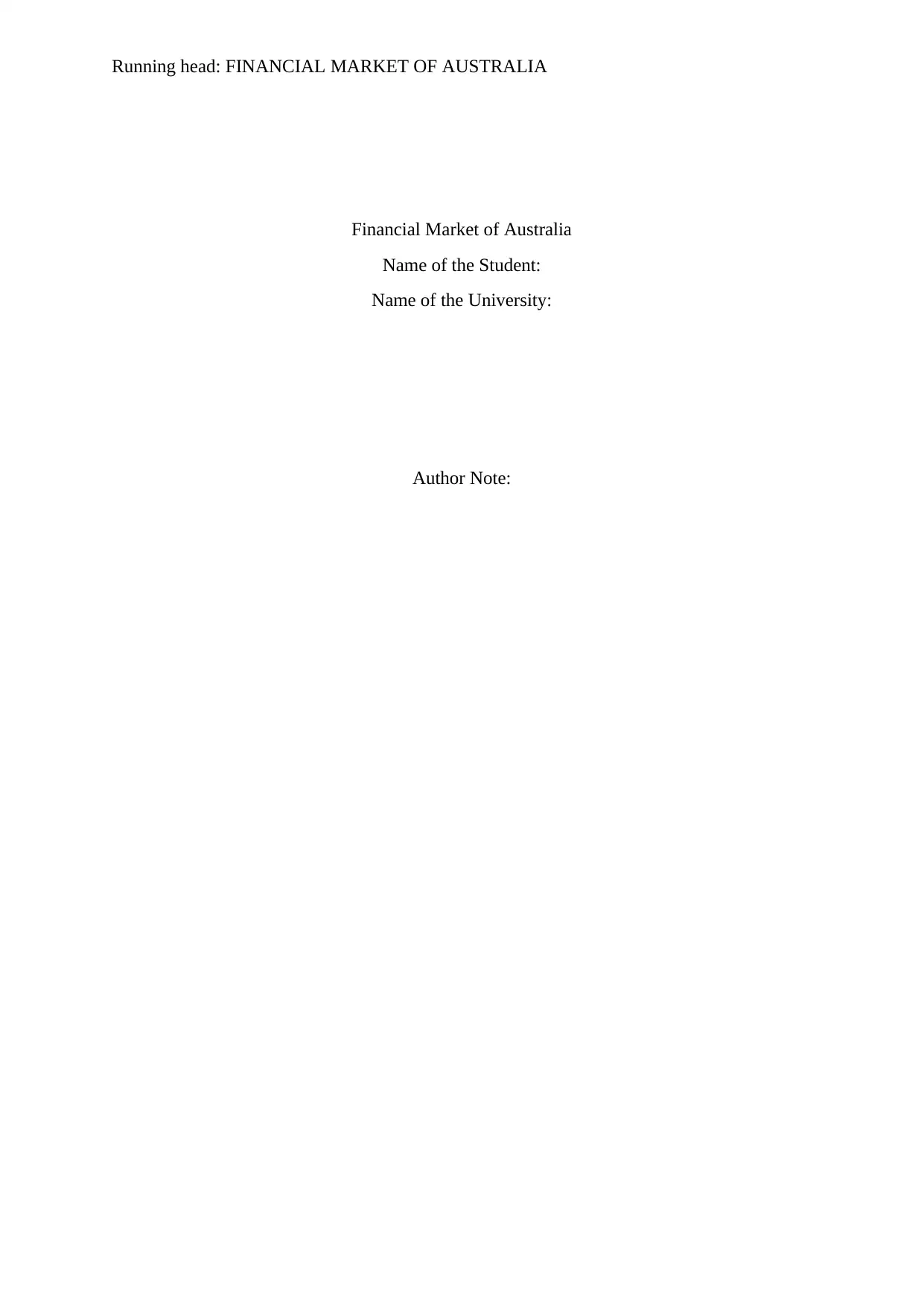
Running head: FINANCIAL MARKET OF AUSTRALIA
Financial Market of Australia
Name of the Student:
Name of the University:
Author Note:
Financial Market of Australia
Name of the Student:
Name of the University:
Author Note:
Paraphrase This Document
Need a fresh take? Get an instant paraphrase of this document with our AI Paraphraser
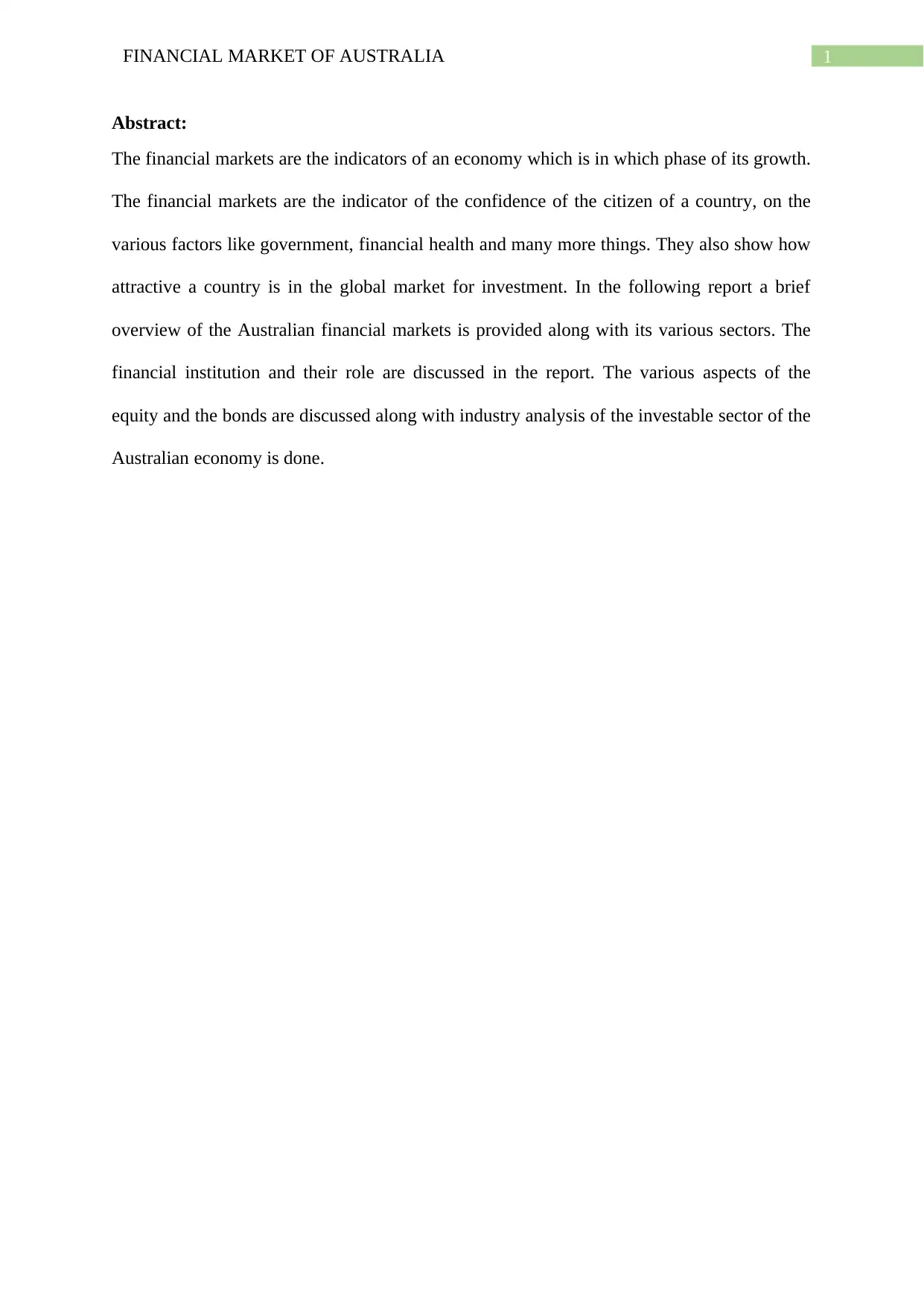
1FINANCIAL MARKET OF AUSTRALIA
Abstract:
The financial markets are the indicators of an economy which is in which phase of its growth.
The financial markets are the indicator of the confidence of the citizen of a country, on the
various factors like government, financial health and many more things. They also show how
attractive a country is in the global market for investment. In the following report a brief
overview of the Australian financial markets is provided along with its various sectors. The
financial institution and their role are discussed in the report. The various aspects of the
equity and the bonds are discussed along with industry analysis of the investable sector of the
Australian economy is done.
Abstract:
The financial markets are the indicators of an economy which is in which phase of its growth.
The financial markets are the indicator of the confidence of the citizen of a country, on the
various factors like government, financial health and many more things. They also show how
attractive a country is in the global market for investment. In the following report a brief
overview of the Australian financial markets is provided along with its various sectors. The
financial institution and their role are discussed in the report. The various aspects of the
equity and the bonds are discussed along with industry analysis of the investable sector of the
Australian economy is done.
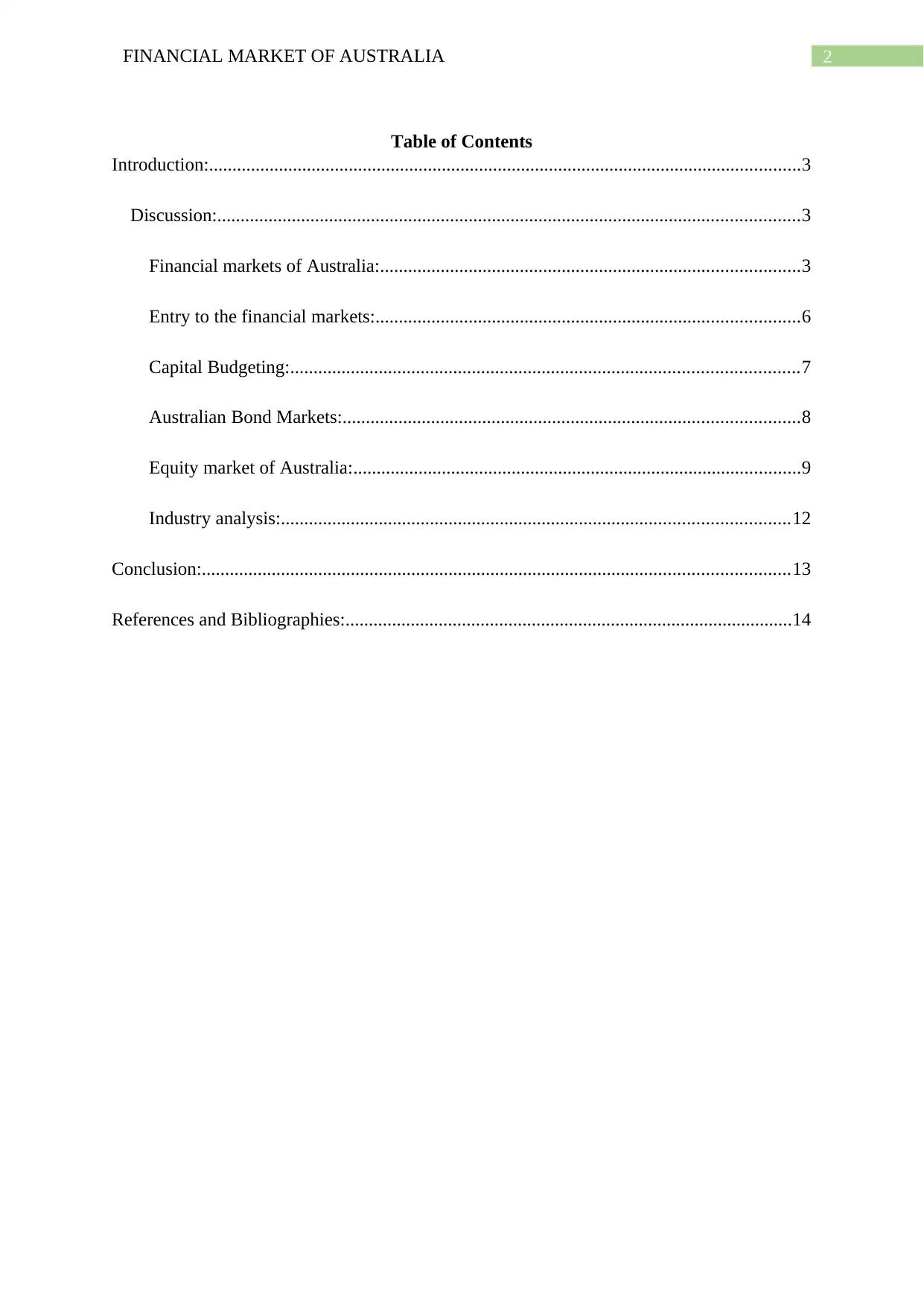
2FINANCIAL MARKET OF AUSTRALIA
Table of Contents
Introduction:...............................................................................................................................3
Discussion:.............................................................................................................................3
Financial markets of Australia:..........................................................................................3
Entry to the financial markets:...........................................................................................6
Capital Budgeting:.............................................................................................................7
Australian Bond Markets:..................................................................................................8
Equity market of Australia:................................................................................................9
Industry analysis:.............................................................................................................12
Conclusion:..............................................................................................................................13
References and Bibliographies:................................................................................................14
Table of Contents
Introduction:...............................................................................................................................3
Discussion:.............................................................................................................................3
Financial markets of Australia:..........................................................................................3
Entry to the financial markets:...........................................................................................6
Capital Budgeting:.............................................................................................................7
Australian Bond Markets:..................................................................................................8
Equity market of Australia:................................................................................................9
Industry analysis:.............................................................................................................12
Conclusion:..............................................................................................................................13
References and Bibliographies:................................................................................................14
⊘ This is a preview!⊘
Do you want full access?
Subscribe today to unlock all pages.

Trusted by 1+ million students worldwide
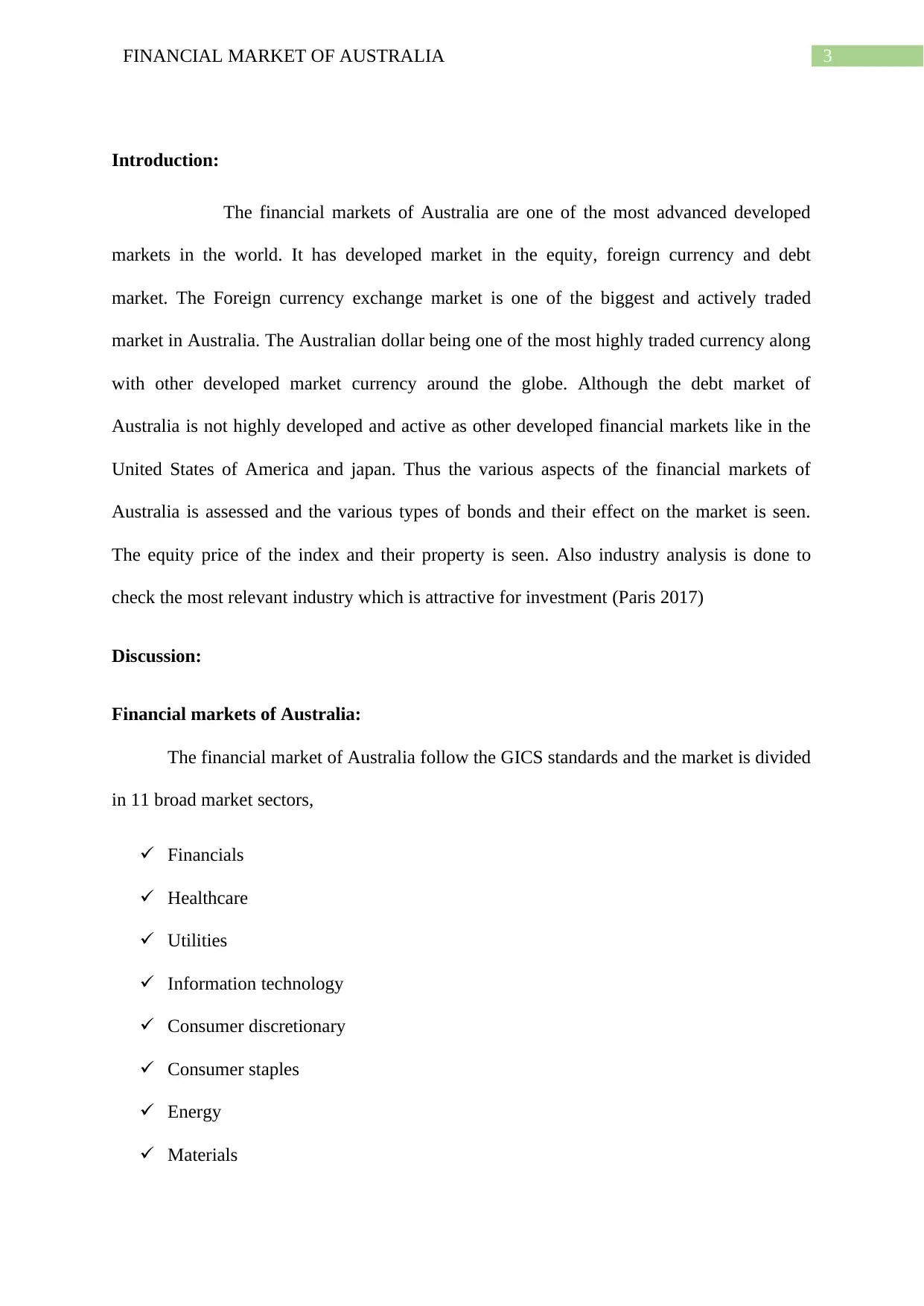
3FINANCIAL MARKET OF AUSTRALIA
Introduction:
The financial markets of Australia are one of the most advanced developed
markets in the world. It has developed market in the equity, foreign currency and debt
market. The Foreign currency exchange market is one of the biggest and actively traded
market in Australia. The Australian dollar being one of the most highly traded currency along
with other developed market currency around the globe. Although the debt market of
Australia is not highly developed and active as other developed financial markets like in the
United States of America and japan. Thus the various aspects of the financial markets of
Australia is assessed and the various types of bonds and their effect on the market is seen.
The equity price of the index and their property is seen. Also industry analysis is done to
check the most relevant industry which is attractive for investment (Paris 2017)
Discussion:
Financial markets of Australia:
The financial market of Australia follow the GICS standards and the market is divided
in 11 broad market sectors,
Financials
Healthcare
Utilities
Information technology
Consumer discretionary
Consumer staples
Energy
Materials
Introduction:
The financial markets of Australia are one of the most advanced developed
markets in the world. It has developed market in the equity, foreign currency and debt
market. The Foreign currency exchange market is one of the biggest and actively traded
market in Australia. The Australian dollar being one of the most highly traded currency along
with other developed market currency around the globe. Although the debt market of
Australia is not highly developed and active as other developed financial markets like in the
United States of America and japan. Thus the various aspects of the financial markets of
Australia is assessed and the various types of bonds and their effect on the market is seen.
The equity price of the index and their property is seen. Also industry analysis is done to
check the most relevant industry which is attractive for investment (Paris 2017)
Discussion:
Financial markets of Australia:
The financial market of Australia follow the GICS standards and the market is divided
in 11 broad market sectors,
Financials
Healthcare
Utilities
Information technology
Consumer discretionary
Consumer staples
Energy
Materials
Paraphrase This Document
Need a fresh take? Get an instant paraphrase of this document with our AI Paraphraser
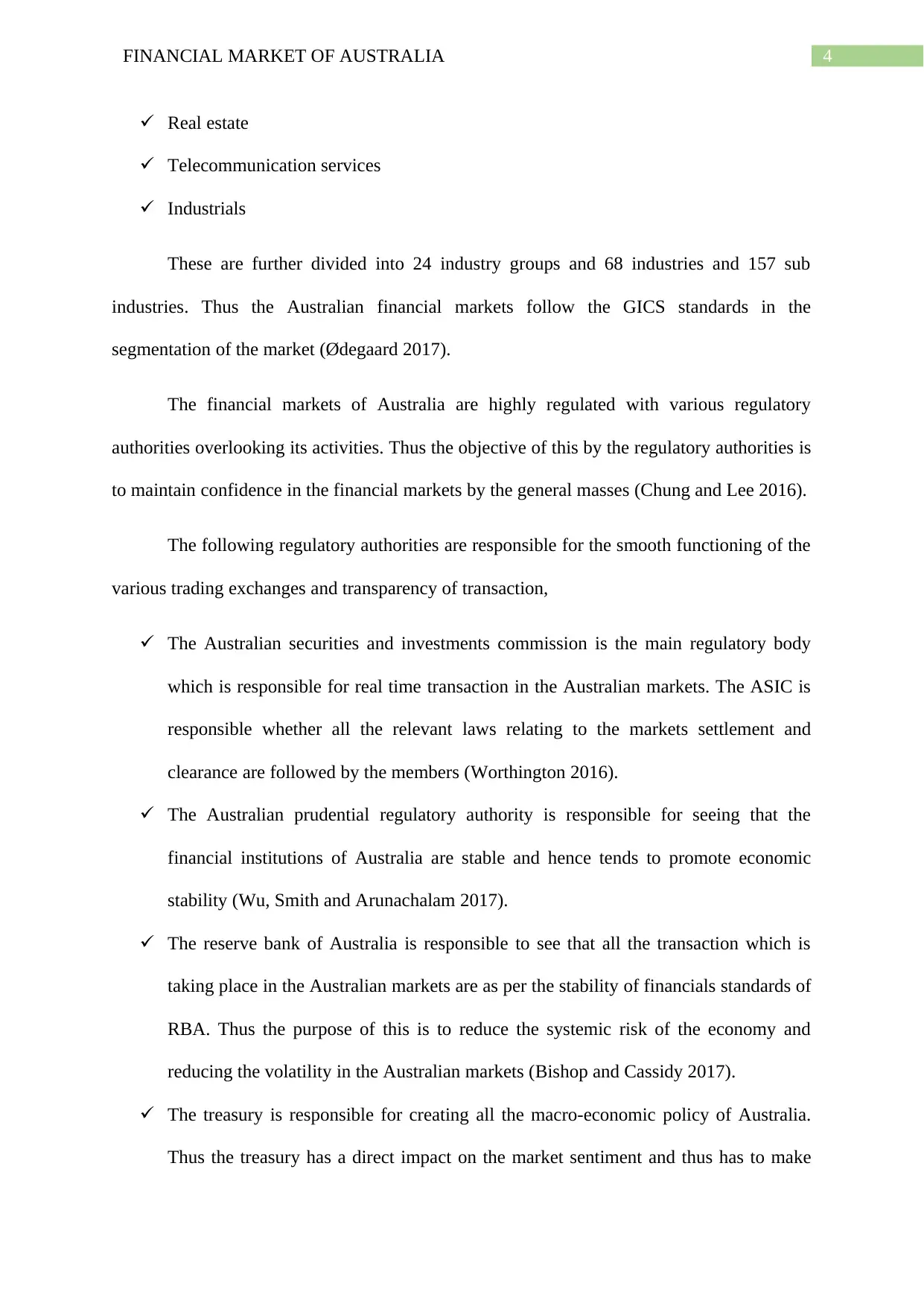
4FINANCIAL MARKET OF AUSTRALIA
Real estate
Telecommunication services
Industrials
These are further divided into 24 industry groups and 68 industries and 157 sub
industries. Thus the Australian financial markets follow the GICS standards in the
segmentation of the market (Ødegaard 2017).
The financial markets of Australia are highly regulated with various regulatory
authorities overlooking its activities. Thus the objective of this by the regulatory authorities is
to maintain confidence in the financial markets by the general masses (Chung and Lee 2016).
The following regulatory authorities are responsible for the smooth functioning of the
various trading exchanges and transparency of transaction,
The Australian securities and investments commission is the main regulatory body
which is responsible for real time transaction in the Australian markets. The ASIC is
responsible whether all the relevant laws relating to the markets settlement and
clearance are followed by the members (Worthington 2016).
The Australian prudential regulatory authority is responsible for seeing that the
financial institutions of Australia are stable and hence tends to promote economic
stability (Wu, Smith and Arunachalam 2017).
The reserve bank of Australia is responsible to see that all the transaction which is
taking place in the Australian markets are as per the stability of financials standards of
RBA. Thus the purpose of this is to reduce the systemic risk of the economy and
reducing the volatility in the Australian markets (Bishop and Cassidy 2017).
The treasury is responsible for creating all the macro-economic policy of Australia.
Thus the treasury has a direct impact on the market sentiment and thus has to make
Real estate
Telecommunication services
Industrials
These are further divided into 24 industry groups and 68 industries and 157 sub
industries. Thus the Australian financial markets follow the GICS standards in the
segmentation of the market (Ødegaard 2017).
The financial markets of Australia are highly regulated with various regulatory
authorities overlooking its activities. Thus the objective of this by the regulatory authorities is
to maintain confidence in the financial markets by the general masses (Chung and Lee 2016).
The following regulatory authorities are responsible for the smooth functioning of the
various trading exchanges and transparency of transaction,
The Australian securities and investments commission is the main regulatory body
which is responsible for real time transaction in the Australian markets. The ASIC is
responsible whether all the relevant laws relating to the markets settlement and
clearance are followed by the members (Worthington 2016).
The Australian prudential regulatory authority is responsible for seeing that the
financial institutions of Australia are stable and hence tends to promote economic
stability (Wu, Smith and Arunachalam 2017).
The reserve bank of Australia is responsible to see that all the transaction which is
taking place in the Australian markets are as per the stability of financials standards of
RBA. Thus the purpose of this is to reduce the systemic risk of the economy and
reducing the volatility in the Australian markets (Bishop and Cassidy 2017).
The treasury is responsible for creating all the macro-economic policy of Australia.
Thus the treasury has a direct impact on the market sentiment and thus has to make
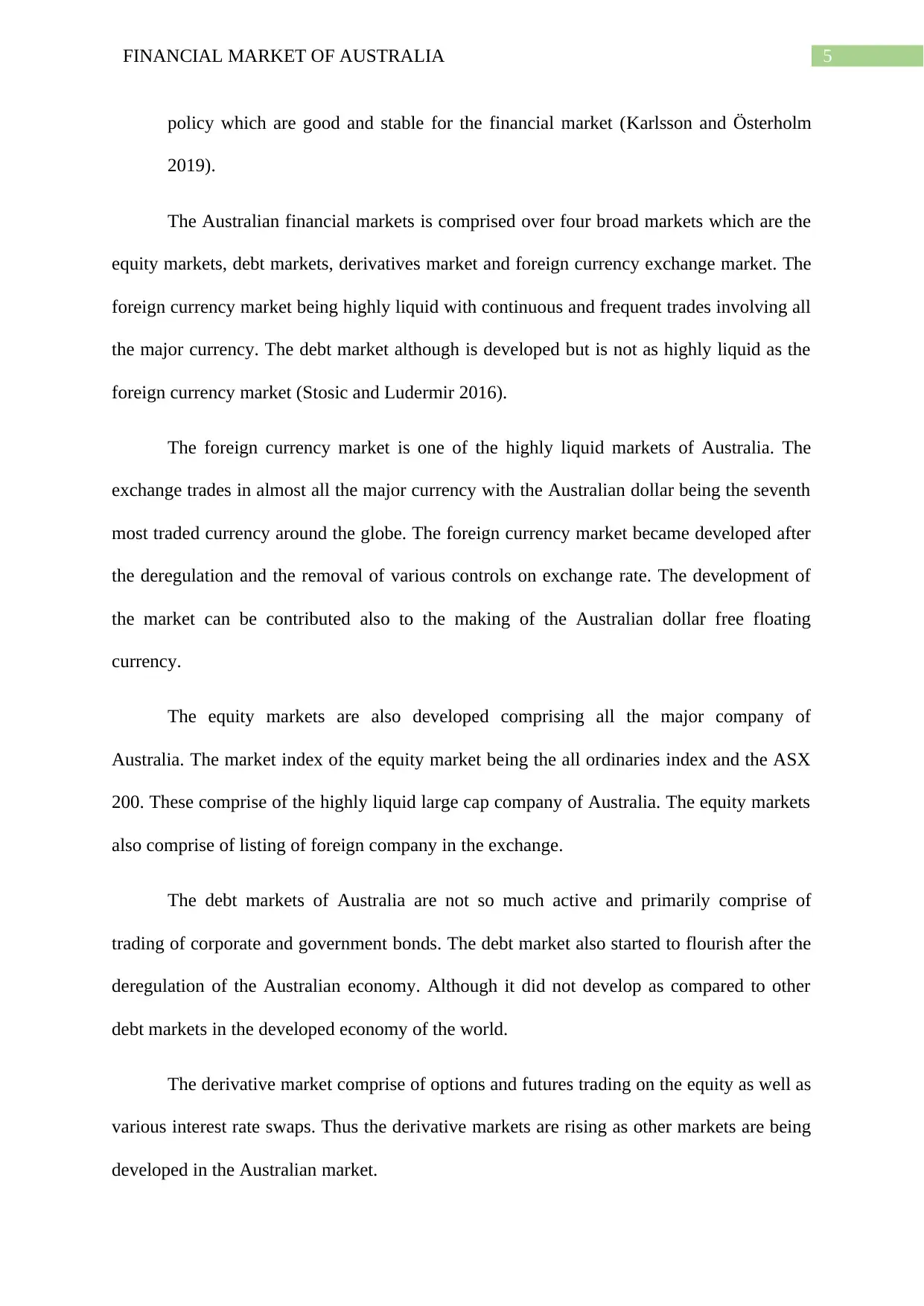
5FINANCIAL MARKET OF AUSTRALIA
policy which are good and stable for the financial market (Karlsson and Österholm
2019).
The Australian financial markets is comprised over four broad markets which are the
equity markets, debt markets, derivatives market and foreign currency exchange market. The
foreign currency market being highly liquid with continuous and frequent trades involving all
the major currency. The debt market although is developed but is not as highly liquid as the
foreign currency market (Stosic and Ludermir 2016).
The foreign currency market is one of the highly liquid markets of Australia. The
exchange trades in almost all the major currency with the Australian dollar being the seventh
most traded currency around the globe. The foreign currency market became developed after
the deregulation and the removal of various controls on exchange rate. The development of
the market can be contributed also to the making of the Australian dollar free floating
currency.
The equity markets are also developed comprising all the major company of
Australia. The market index of the equity market being the all ordinaries index and the ASX
200. These comprise of the highly liquid large cap company of Australia. The equity markets
also comprise of listing of foreign company in the exchange.
The debt markets of Australia are not so much active and primarily comprise of
trading of corporate and government bonds. The debt market also started to flourish after the
deregulation of the Australian economy. Although it did not develop as compared to other
debt markets in the developed economy of the world.
The derivative market comprise of options and futures trading on the equity as well as
various interest rate swaps. Thus the derivative markets are rising as other markets are being
developed in the Australian market.
policy which are good and stable for the financial market (Karlsson and Österholm
2019).
The Australian financial markets is comprised over four broad markets which are the
equity markets, debt markets, derivatives market and foreign currency exchange market. The
foreign currency market being highly liquid with continuous and frequent trades involving all
the major currency. The debt market although is developed but is not as highly liquid as the
foreign currency market (Stosic and Ludermir 2016).
The foreign currency market is one of the highly liquid markets of Australia. The
exchange trades in almost all the major currency with the Australian dollar being the seventh
most traded currency around the globe. The foreign currency market became developed after
the deregulation and the removal of various controls on exchange rate. The development of
the market can be contributed also to the making of the Australian dollar free floating
currency.
The equity markets are also developed comprising all the major company of
Australia. The market index of the equity market being the all ordinaries index and the ASX
200. These comprise of the highly liquid large cap company of Australia. The equity markets
also comprise of listing of foreign company in the exchange.
The debt markets of Australia are not so much active and primarily comprise of
trading of corporate and government bonds. The debt market also started to flourish after the
deregulation of the Australian economy. Although it did not develop as compared to other
debt markets in the developed economy of the world.
The derivative market comprise of options and futures trading on the equity as well as
various interest rate swaps. Thus the derivative markets are rising as other markets are being
developed in the Australian market.
⊘ This is a preview!⊘
Do you want full access?
Subscribe today to unlock all pages.

Trusted by 1+ million students worldwide
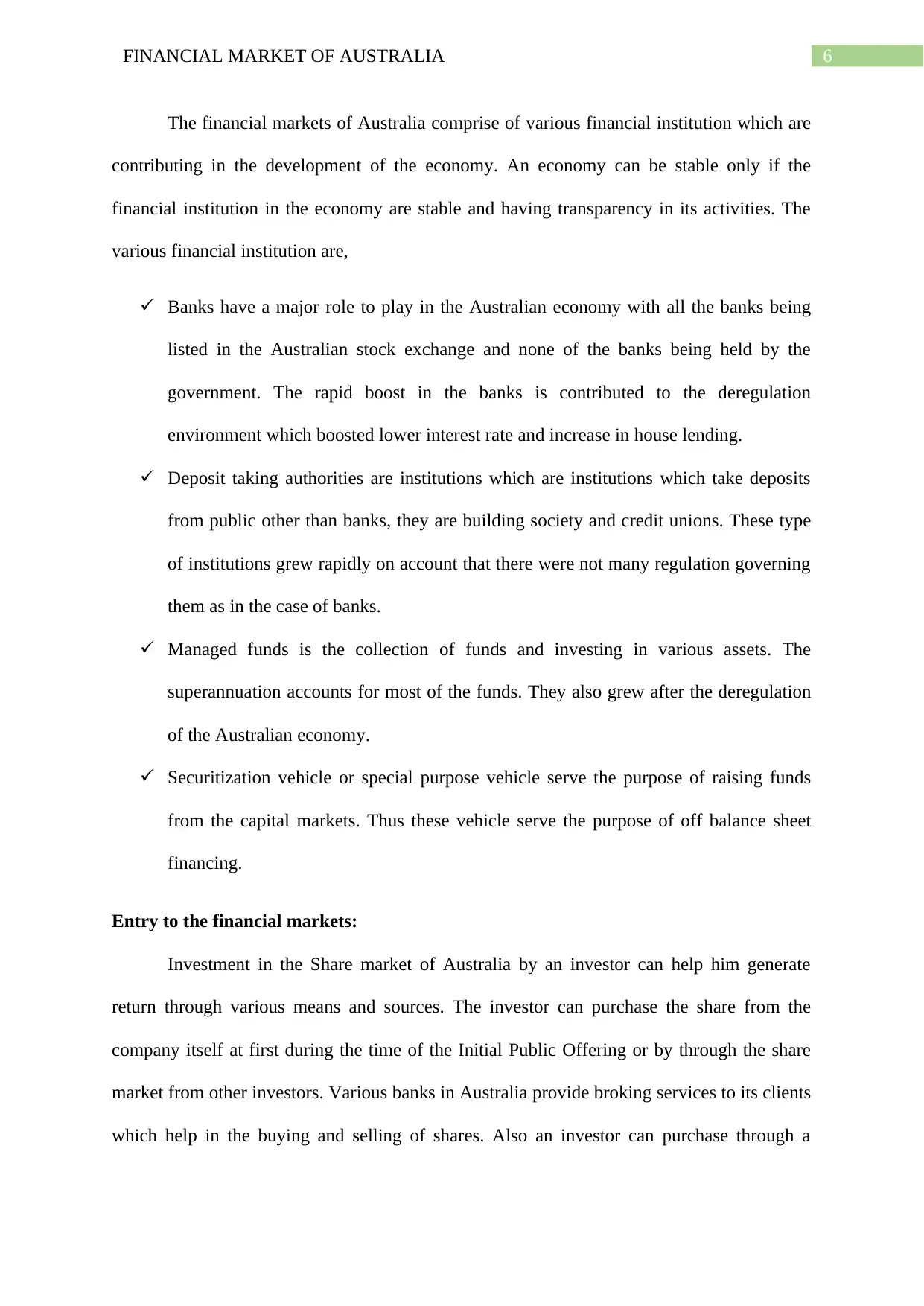
6FINANCIAL MARKET OF AUSTRALIA
The financial markets of Australia comprise of various financial institution which are
contributing in the development of the economy. An economy can be stable only if the
financial institution in the economy are stable and having transparency in its activities. The
various financial institution are,
Banks have a major role to play in the Australian economy with all the banks being
listed in the Australian stock exchange and none of the banks being held by the
government. The rapid boost in the banks is contributed to the deregulation
environment which boosted lower interest rate and increase in house lending.
Deposit taking authorities are institutions which are institutions which take deposits
from public other than banks, they are building society and credit unions. These type
of institutions grew rapidly on account that there were not many regulation governing
them as in the case of banks.
Managed funds is the collection of funds and investing in various assets. The
superannuation accounts for most of the funds. They also grew after the deregulation
of the Australian economy.
Securitization vehicle or special purpose vehicle serve the purpose of raising funds
from the capital markets. Thus these vehicle serve the purpose of off balance sheet
financing.
Entry to the financial markets:
Investment in the Share market of Australia by an investor can help him generate
return through various means and sources. The investor can purchase the share from the
company itself at first during the time of the Initial Public Offering or by through the share
market from other investors. Various banks in Australia provide broking services to its clients
which help in the buying and selling of shares. Also an investor can purchase through a
The financial markets of Australia comprise of various financial institution which are
contributing in the development of the economy. An economy can be stable only if the
financial institution in the economy are stable and having transparency in its activities. The
various financial institution are,
Banks have a major role to play in the Australian economy with all the banks being
listed in the Australian stock exchange and none of the banks being held by the
government. The rapid boost in the banks is contributed to the deregulation
environment which boosted lower interest rate and increase in house lending.
Deposit taking authorities are institutions which are institutions which take deposits
from public other than banks, they are building society and credit unions. These type
of institutions grew rapidly on account that there were not many regulation governing
them as in the case of banks.
Managed funds is the collection of funds and investing in various assets. The
superannuation accounts for most of the funds. They also grew after the deregulation
of the Australian economy.
Securitization vehicle or special purpose vehicle serve the purpose of raising funds
from the capital markets. Thus these vehicle serve the purpose of off balance sheet
financing.
Entry to the financial markets:
Investment in the Share market of Australia by an investor can help him generate
return through various means and sources. The investor can purchase the share from the
company itself at first during the time of the Initial Public Offering or by through the share
market from other investors. Various banks in Australia provide broking services to its clients
which help in the buying and selling of shares. Also an investor can purchase through a
Paraphrase This Document
Need a fresh take? Get an instant paraphrase of this document with our AI Paraphraser
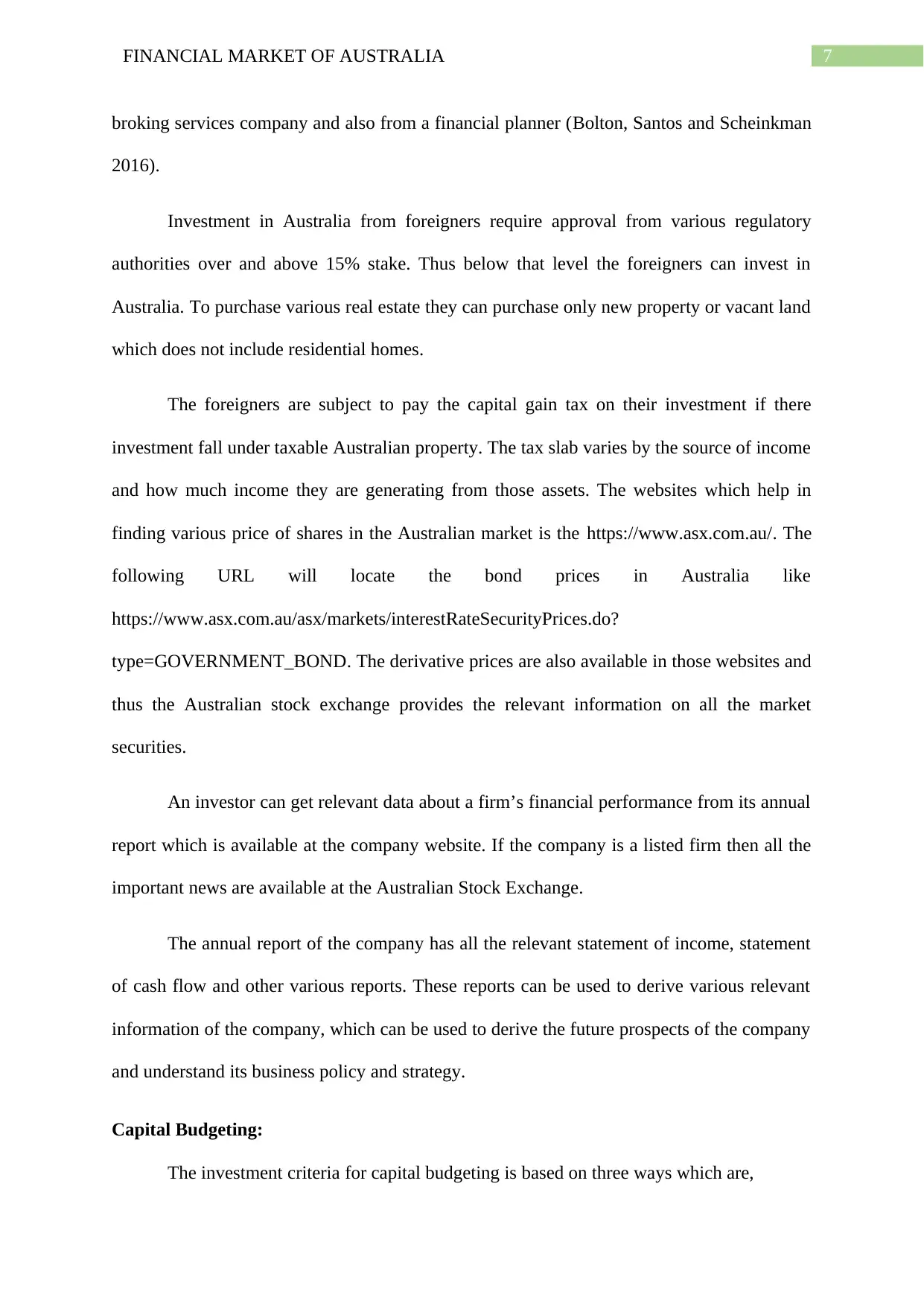
7FINANCIAL MARKET OF AUSTRALIA
broking services company and also from a financial planner (Bolton, Santos and Scheinkman
2016).
Investment in Australia from foreigners require approval from various regulatory
authorities over and above 15% stake. Thus below that level the foreigners can invest in
Australia. To purchase various real estate they can purchase only new property or vacant land
which does not include residential homes.
The foreigners are subject to pay the capital gain tax on their investment if there
investment fall under taxable Australian property. The tax slab varies by the source of income
and how much income they are generating from those assets. The websites which help in
finding various price of shares in the Australian market is the https://www.asx.com.au/. The
following URL will locate the bond prices in Australia like
https://www.asx.com.au/asx/markets/interestRateSecurityPrices.do?
type=GOVERNMENT_BOND. The derivative prices are also available in those websites and
thus the Australian stock exchange provides the relevant information on all the market
securities.
An investor can get relevant data about a firm’s financial performance from its annual
report which is available at the company website. If the company is a listed firm then all the
important news are available at the Australian Stock Exchange.
The annual report of the company has all the relevant statement of income, statement
of cash flow and other various reports. These reports can be used to derive various relevant
information of the company, which can be used to derive the future prospects of the company
and understand its business policy and strategy.
Capital Budgeting:
The investment criteria for capital budgeting is based on three ways which are,
broking services company and also from a financial planner (Bolton, Santos and Scheinkman
2016).
Investment in Australia from foreigners require approval from various regulatory
authorities over and above 15% stake. Thus below that level the foreigners can invest in
Australia. To purchase various real estate they can purchase only new property or vacant land
which does not include residential homes.
The foreigners are subject to pay the capital gain tax on their investment if there
investment fall under taxable Australian property. The tax slab varies by the source of income
and how much income they are generating from those assets. The websites which help in
finding various price of shares in the Australian market is the https://www.asx.com.au/. The
following URL will locate the bond prices in Australia like
https://www.asx.com.au/asx/markets/interestRateSecurityPrices.do?
type=GOVERNMENT_BOND. The derivative prices are also available in those websites and
thus the Australian stock exchange provides the relevant information on all the market
securities.
An investor can get relevant data about a firm’s financial performance from its annual
report which is available at the company website. If the company is a listed firm then all the
important news are available at the Australian Stock Exchange.
The annual report of the company has all the relevant statement of income, statement
of cash flow and other various reports. These reports can be used to derive various relevant
information of the company, which can be used to derive the future prospects of the company
and understand its business policy and strategy.
Capital Budgeting:
The investment criteria for capital budgeting is based on three ways which are,
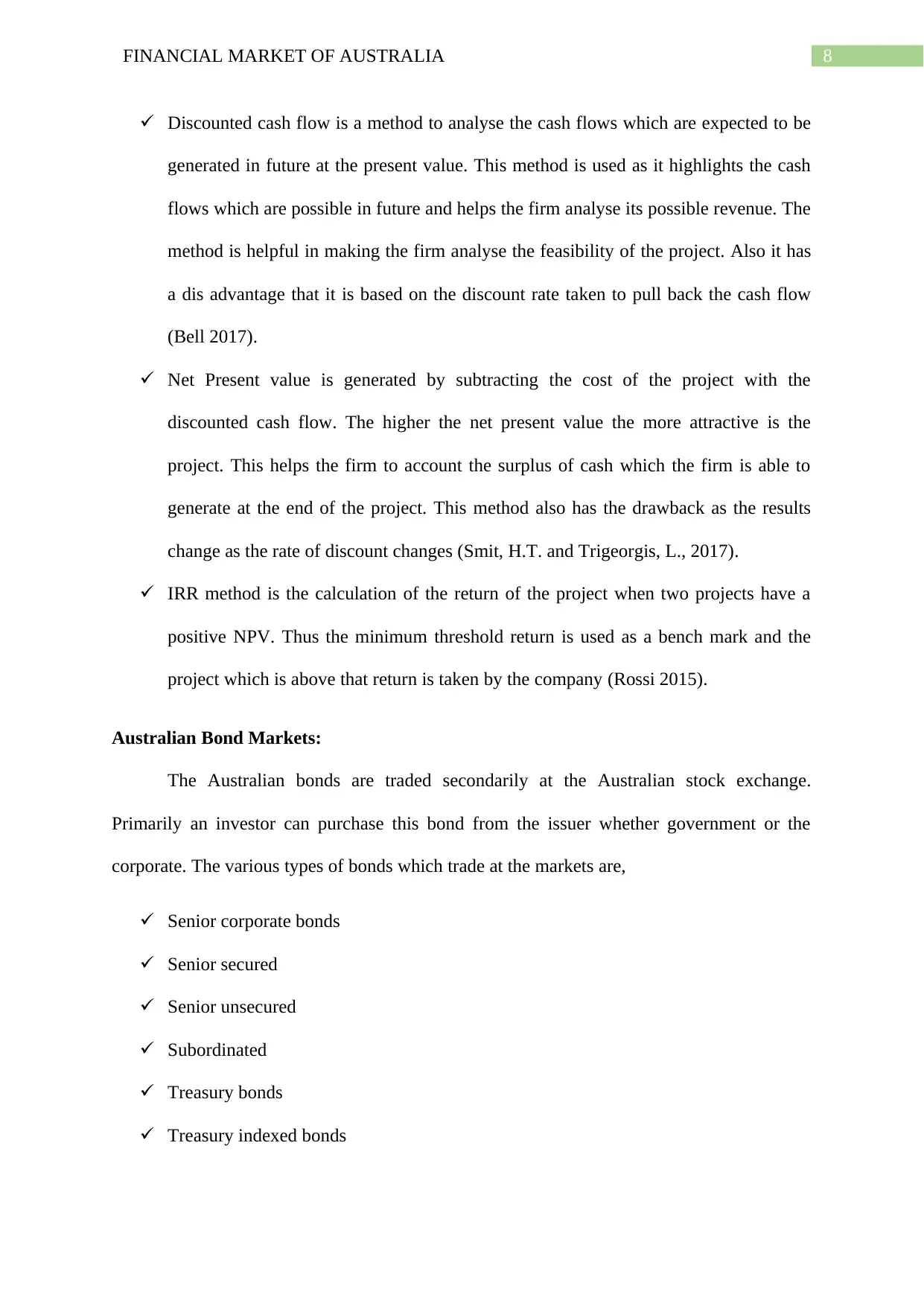
8FINANCIAL MARKET OF AUSTRALIA
Discounted cash flow is a method to analyse the cash flows which are expected to be
generated in future at the present value. This method is used as it highlights the cash
flows which are possible in future and helps the firm analyse its possible revenue. The
method is helpful in making the firm analyse the feasibility of the project. Also it has
a dis advantage that it is based on the discount rate taken to pull back the cash flow
(Bell 2017).
Net Present value is generated by subtracting the cost of the project with the
discounted cash flow. The higher the net present value the more attractive is the
project. This helps the firm to account the surplus of cash which the firm is able to
generate at the end of the project. This method also has the drawback as the results
change as the rate of discount changes (Smit, H.T. and Trigeorgis, L., 2017).
IRR method is the calculation of the return of the project when two projects have a
positive NPV. Thus the minimum threshold return is used as a bench mark and the
project which is above that return is taken by the company (Rossi 2015).
Australian Bond Markets:
The Australian bonds are traded secondarily at the Australian stock exchange.
Primarily an investor can purchase this bond from the issuer whether government or the
corporate. The various types of bonds which trade at the markets are,
Senior corporate bonds
Senior secured
Senior unsecured
Subordinated
Treasury bonds
Treasury indexed bonds
Discounted cash flow is a method to analyse the cash flows which are expected to be
generated in future at the present value. This method is used as it highlights the cash
flows which are possible in future and helps the firm analyse its possible revenue. The
method is helpful in making the firm analyse the feasibility of the project. Also it has
a dis advantage that it is based on the discount rate taken to pull back the cash flow
(Bell 2017).
Net Present value is generated by subtracting the cost of the project with the
discounted cash flow. The higher the net present value the more attractive is the
project. This helps the firm to account the surplus of cash which the firm is able to
generate at the end of the project. This method also has the drawback as the results
change as the rate of discount changes (Smit, H.T. and Trigeorgis, L., 2017).
IRR method is the calculation of the return of the project when two projects have a
positive NPV. Thus the minimum threshold return is used as a bench mark and the
project which is above that return is taken by the company (Rossi 2015).
Australian Bond Markets:
The Australian bonds are traded secondarily at the Australian stock exchange.
Primarily an investor can purchase this bond from the issuer whether government or the
corporate. The various types of bonds which trade at the markets are,
Senior corporate bonds
Senior secured
Senior unsecured
Subordinated
Treasury bonds
Treasury indexed bonds
⊘ This is a preview!⊘
Do you want full access?
Subscribe today to unlock all pages.

Trusted by 1+ million students worldwide
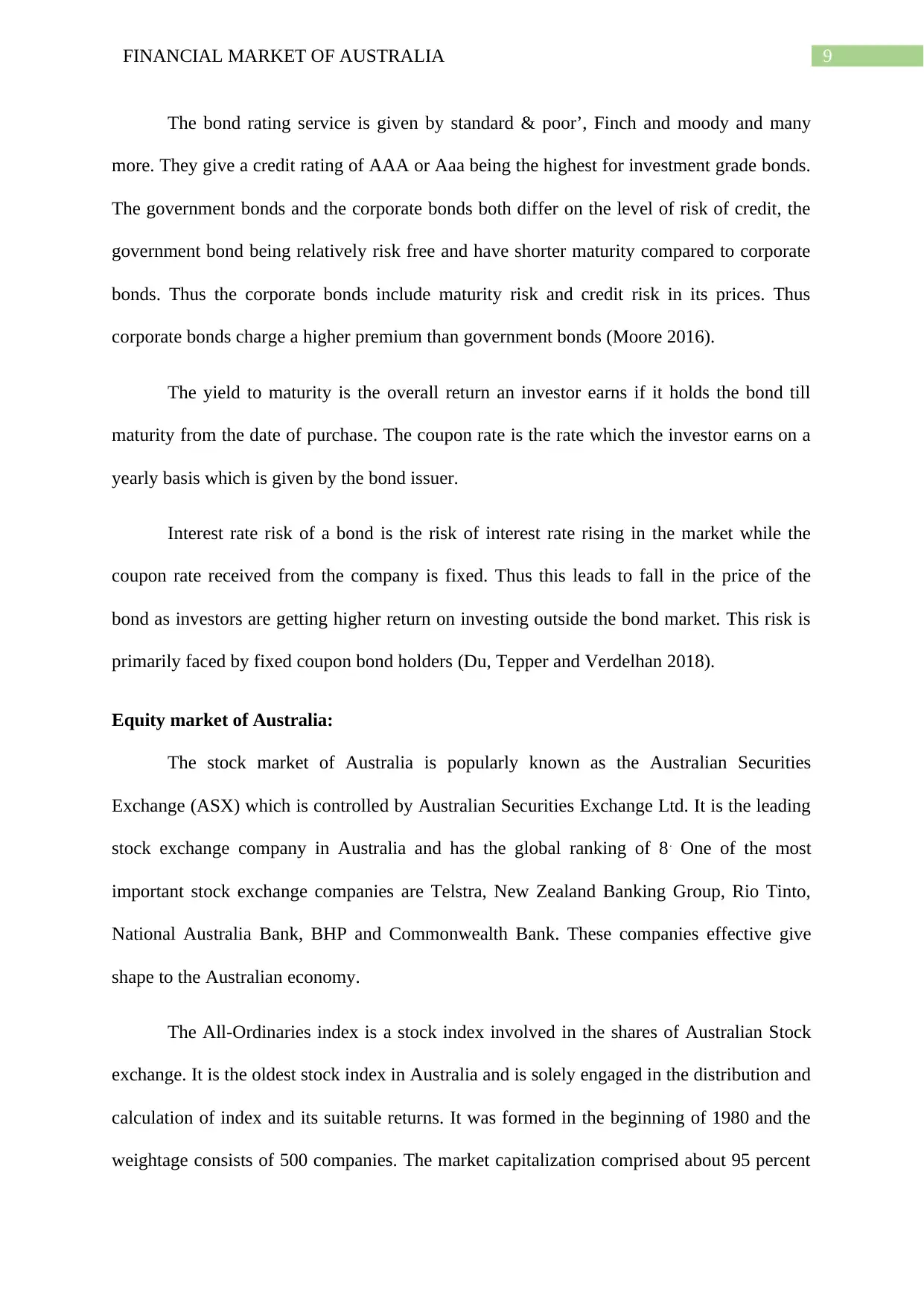
9FINANCIAL MARKET OF AUSTRALIA
The bond rating service is given by standard & poor’, Finch and moody and many
more. They give a credit rating of AAA or Aaa being the highest for investment grade bonds.
The government bonds and the corporate bonds both differ on the level of risk of credit, the
government bond being relatively risk free and have shorter maturity compared to corporate
bonds. Thus the corporate bonds include maturity risk and credit risk in its prices. Thus
corporate bonds charge a higher premium than government bonds (Moore 2016).
The yield to maturity is the overall return an investor earns if it holds the bond till
maturity from the date of purchase. The coupon rate is the rate which the investor earns on a
yearly basis which is given by the bond issuer.
Interest rate risk of a bond is the risk of interest rate rising in the market while the
coupon rate received from the company is fixed. Thus this leads to fall in the price of the
bond as investors are getting higher return on investing outside the bond market. This risk is
primarily faced by fixed coupon bond holders (Du, Tepper and Verdelhan 2018).
Equity market of Australia:
The stock market of Australia is popularly known as the Australian Securities
Exchange (ASX) which is controlled by Australian Securities Exchange Ltd. It is the leading
stock exchange company in Australia and has the global ranking of 8. One of the most
important stock exchange companies are Telstra, New Zealand Banking Group, Rio Tinto,
National Australia Bank, BHP and Commonwealth Bank. These companies effective give
shape to the Australian economy.
The All-Ordinaries index is a stock index involved in the shares of Australian Stock
exchange. It is the oldest stock index in Australia and is solely engaged in the distribution and
calculation of index and its suitable returns. It was formed in the beginning of 1980 and the
weightage consists of 500 companies. The market capitalization comprised about 95 percent
The bond rating service is given by standard & poor’, Finch and moody and many
more. They give a credit rating of AAA or Aaa being the highest for investment grade bonds.
The government bonds and the corporate bonds both differ on the level of risk of credit, the
government bond being relatively risk free and have shorter maturity compared to corporate
bonds. Thus the corporate bonds include maturity risk and credit risk in its prices. Thus
corporate bonds charge a higher premium than government bonds (Moore 2016).
The yield to maturity is the overall return an investor earns if it holds the bond till
maturity from the date of purchase. The coupon rate is the rate which the investor earns on a
yearly basis which is given by the bond issuer.
Interest rate risk of a bond is the risk of interest rate rising in the market while the
coupon rate received from the company is fixed. Thus this leads to fall in the price of the
bond as investors are getting higher return on investing outside the bond market. This risk is
primarily faced by fixed coupon bond holders (Du, Tepper and Verdelhan 2018).
Equity market of Australia:
The stock market of Australia is popularly known as the Australian Securities
Exchange (ASX) which is controlled by Australian Securities Exchange Ltd. It is the leading
stock exchange company in Australia and has the global ranking of 8. One of the most
important stock exchange companies are Telstra, New Zealand Banking Group, Rio Tinto,
National Australia Bank, BHP and Commonwealth Bank. These companies effective give
shape to the Australian economy.
The All-Ordinaries index is a stock index involved in the shares of Australian Stock
exchange. It is the oldest stock index in Australia and is solely engaged in the distribution and
calculation of index and its suitable returns. It was formed in the beginning of 1980 and the
weightage consists of 500 companies. The market capitalization comprised about 95 percent
Paraphrase This Document
Need a fresh take? Get an instant paraphrase of this document with our AI Paraphraser
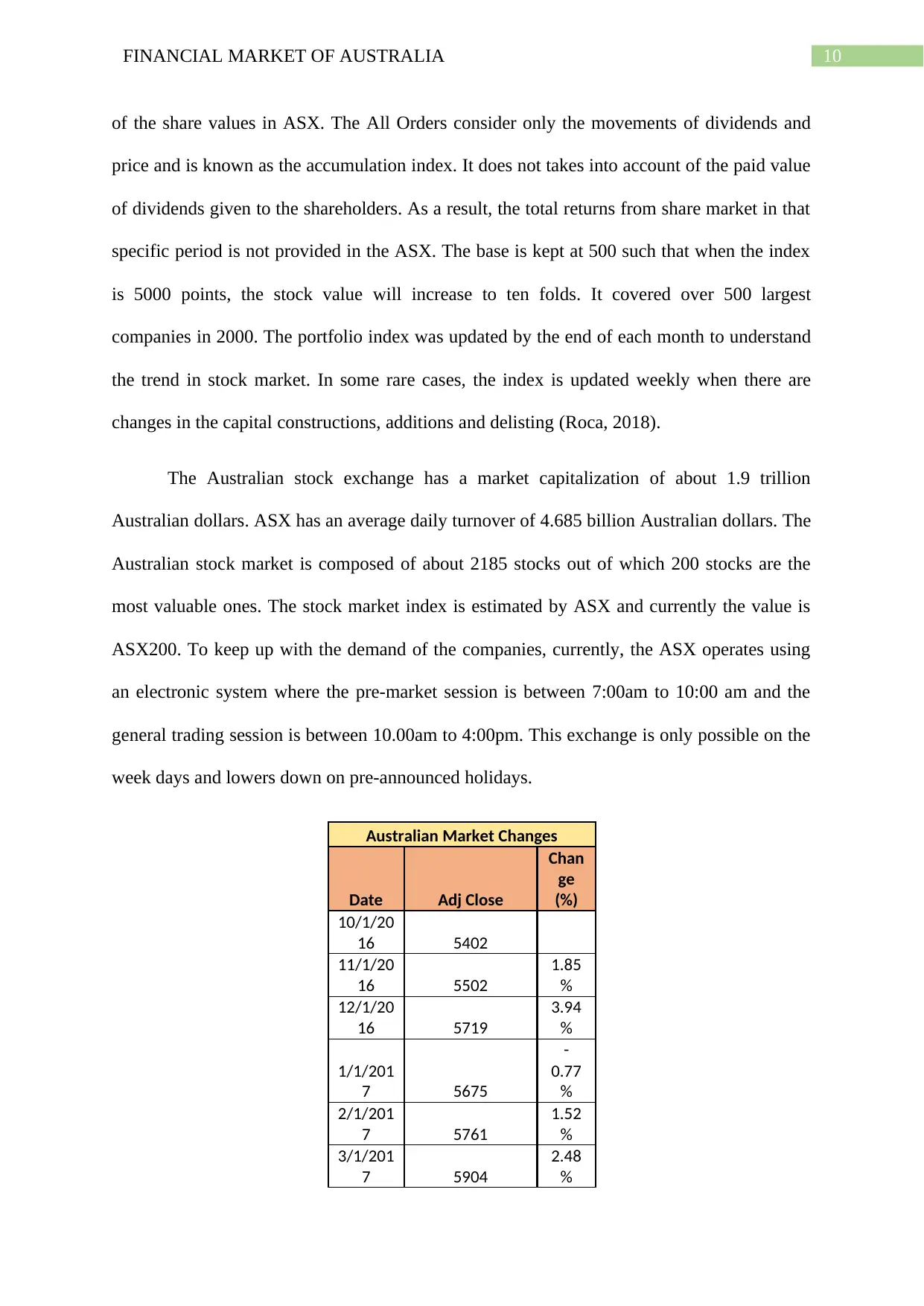
10FINANCIAL MARKET OF AUSTRALIA
of the share values in ASX. The All Orders consider only the movements of dividends and
price and is known as the accumulation index. It does not takes into account of the paid value
of dividends given to the shareholders. As a result, the total returns from share market in that
specific period is not provided in the ASX. The base is kept at 500 such that when the index
is 5000 points, the stock value will increase to ten folds. It covered over 500 largest
companies in 2000. The portfolio index was updated by the end of each month to understand
the trend in stock market. In some rare cases, the index is updated weekly when there are
changes in the capital constructions, additions and delisting (Roca, 2018).
The Australian stock exchange has a market capitalization of about 1.9 trillion
Australian dollars. ASX has an average daily turnover of 4.685 billion Australian dollars. The
Australian stock market is composed of about 2185 stocks out of which 200 stocks are the
most valuable ones. The stock market index is estimated by ASX and currently the value is
ASX200. To keep up with the demand of the companies, currently, the ASX operates using
an electronic system where the pre-market session is between 7:00am to 10:00 am and the
general trading session is between 10.00am to 4:00pm. This exchange is only possible on the
week days and lowers down on pre-announced holidays.
Australian Market Changes
Date Adj Close
Chan
ge
(%)
10/1/20
16 5402
11/1/20
16 5502
1.85
%
12/1/20
16 5719
3.94
%
1/1/201
7 5675
-
0.77
%
2/1/201
7 5761
1.52
%
3/1/201
7 5904
2.48
%
of the share values in ASX. The All Orders consider only the movements of dividends and
price and is known as the accumulation index. It does not takes into account of the paid value
of dividends given to the shareholders. As a result, the total returns from share market in that
specific period is not provided in the ASX. The base is kept at 500 such that when the index
is 5000 points, the stock value will increase to ten folds. It covered over 500 largest
companies in 2000. The portfolio index was updated by the end of each month to understand
the trend in stock market. In some rare cases, the index is updated weekly when there are
changes in the capital constructions, additions and delisting (Roca, 2018).
The Australian stock exchange has a market capitalization of about 1.9 trillion
Australian dollars. ASX has an average daily turnover of 4.685 billion Australian dollars. The
Australian stock market is composed of about 2185 stocks out of which 200 stocks are the
most valuable ones. The stock market index is estimated by ASX and currently the value is
ASX200. To keep up with the demand of the companies, currently, the ASX operates using
an electronic system where the pre-market session is between 7:00am to 10:00 am and the
general trading session is between 10.00am to 4:00pm. This exchange is only possible on the
week days and lowers down on pre-announced holidays.
Australian Market Changes
Date Adj Close
Chan
ge
(%)
10/1/20
16 5402
11/1/20
16 5502
1.85
%
12/1/20
16 5719
3.94
%
1/1/201
7 5675
-
0.77
%
2/1/201
7 5761
1.52
%
3/1/201
7 5904
2.48
%
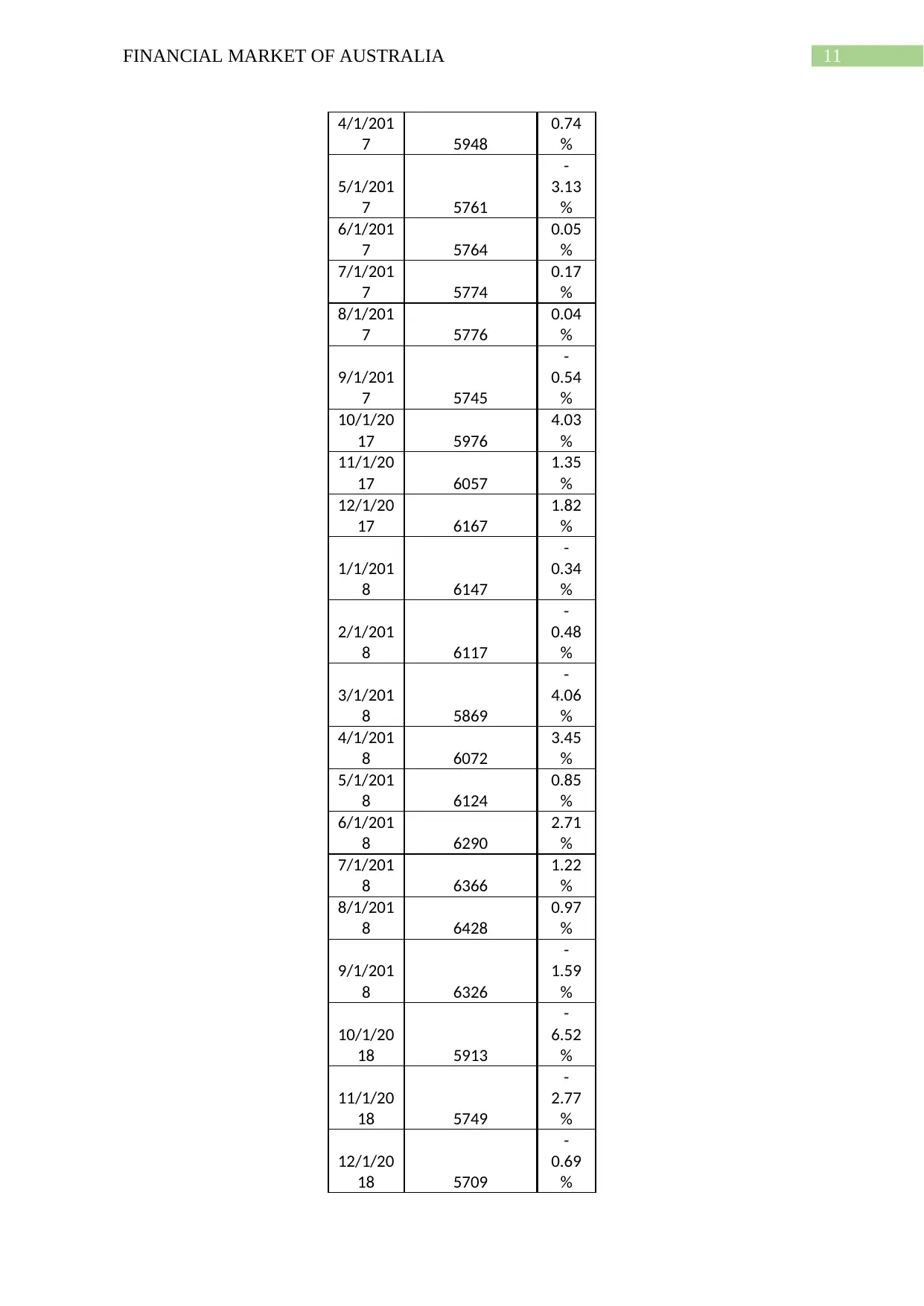
11FINANCIAL MARKET OF AUSTRALIA
4/1/201
7 5948
0.74
%
5/1/201
7 5761
-
3.13
%
6/1/201
7 5764
0.05
%
7/1/201
7 5774
0.17
%
8/1/201
7 5776
0.04
%
9/1/201
7 5745
-
0.54
%
10/1/20
17 5976
4.03
%
11/1/20
17 6057
1.35
%
12/1/20
17 6167
1.82
%
1/1/201
8 6147
-
0.34
%
2/1/201
8 6117
-
0.48
%
3/1/201
8 5869
-
4.06
%
4/1/201
8 6072
3.45
%
5/1/201
8 6124
0.85
%
6/1/201
8 6290
2.71
%
7/1/201
8 6366
1.22
%
8/1/201
8 6428
0.97
%
9/1/201
8 6326
-
1.59
%
10/1/20
18 5913
-
6.52
%
11/1/20
18 5749
-
2.77
%
12/1/20
18 5709
-
0.69
%
4/1/201
7 5948
0.74
%
5/1/201
7 5761
-
3.13
%
6/1/201
7 5764
0.05
%
7/1/201
7 5774
0.17
%
8/1/201
7 5776
0.04
%
9/1/201
7 5745
-
0.54
%
10/1/20
17 5976
4.03
%
11/1/20
17 6057
1.35
%
12/1/20
17 6167
1.82
%
1/1/201
8 6147
-
0.34
%
2/1/201
8 6117
-
0.48
%
3/1/201
8 5869
-
4.06
%
4/1/201
8 6072
3.45
%
5/1/201
8 6124
0.85
%
6/1/201
8 6290
2.71
%
7/1/201
8 6366
1.22
%
8/1/201
8 6428
0.97
%
9/1/201
8 6326
-
1.59
%
10/1/20
18 5913
-
6.52
%
11/1/20
18 5749
-
2.77
%
12/1/20
18 5709
-
0.69
%
⊘ This is a preview!⊘
Do you want full access?
Subscribe today to unlock all pages.

Trusted by 1+ million students worldwide
1 out of 18
Related Documents
Your All-in-One AI-Powered Toolkit for Academic Success.
+13062052269
info@desklib.com
Available 24*7 on WhatsApp / Email
![[object Object]](/_next/static/media/star-bottom.7253800d.svg)
Unlock your academic potential
Copyright © 2020–2025 A2Z Services. All Rights Reserved. Developed and managed by ZUCOL.




